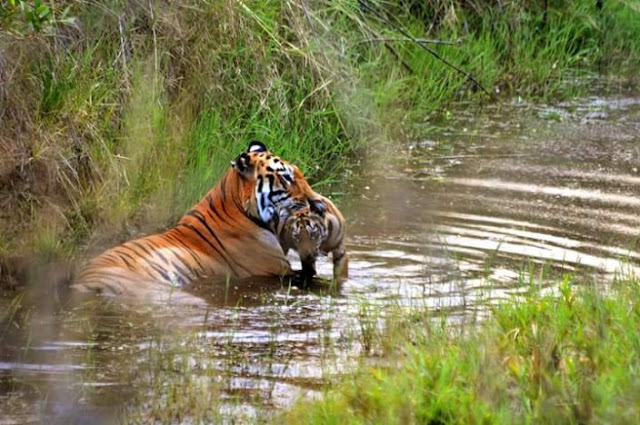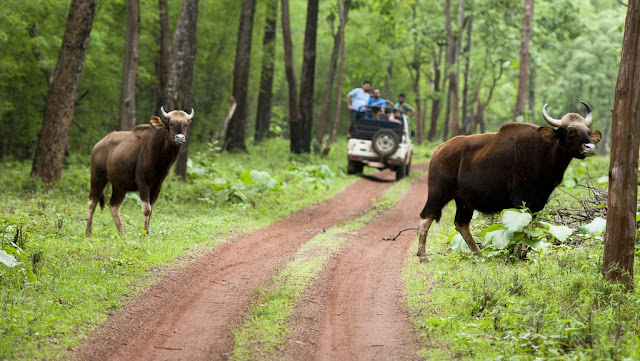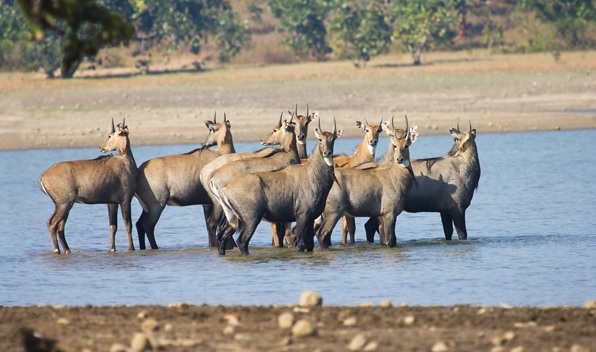Know About Tadoba National Park
WildTrails Recent Sightings - The One-Stop Destination for all your Wildlife Travels
Tadoba National Park or Tadoba Andhari tiger reserve is located in Maharashtra district. It is one among the fifty tiger reserves that are located in India. It is the largest and the oldest park in the state. The park gets its name from the tribal God worshipped in this region, Taru or Tadoba and, the river that runs through the region, Andhari. Taru was a chief in the tribal village who was killed by a tiger. He is represented as a God and a shrine has been dedicated to him on the banks of the river. Tribes in the buffer area celebrate a festival in the shrine during winter season. Tourists are however not allowed to be a part of this festival.
Tadoba Tiger Sightings is very famous for those who want to spot the Bengal tiger. The gypsy safari of the park is also called as the tiger safari. The park is famous for birdwatching and spotting tigers.
 |
| Tadoba Safari Booking |
Different Areas in the Park
The park is divided into three regions namely, Tadoba north region, Morhurli region and the Kolsa south range. There are three water sources in the park namely Tadoba river, Tadobalake and the Kolsa lake. Safari is allowed in all three regions.
Moharli or Mahurli zone : This is the best spot in the park to spot animals. It is a famous spot in the safari. The gate to this zone is accessed through other two zones. This is the central part of the park.
Tadoba zone : This zone is famous for scenic locations and animal spotting. There are four entrances to this zone.
Kolsa zone : This zone is filled with forest region. Spotting wild animals is noteasier here. Safari here focuses on the flora of the park. Geographically, three regions of the park are famous for any wildlife safari.
North : The northern part of the park has dense forest and hills covered with dense forest. The elevated hill region forms a natural boundary for the park. West – Western part of the park has hill boundaries too. The elevation ranges from 200m to 350m. The hills descend to form terrain slops and valleys where rich population of animals can be found.
South : The southern part of the park is flourished by Tadobalake for 300 acres. This border separates the farmland from the park. This area is famous for spotting mugger, crocodiles and many other animals that come to quench their thirst.
Flora of Tadoba National Park
The Tadoba national park is filled with dry deciduous forest and the core area has dense woodlands. Teak is very commonly found in the park. Other top wild trees in the park are crepe myrtle, semal, hirda, crocodile bark, wodier tree and others. In the deep area of the park, fame of forests, axle wood and others are commonly found. Near the lake, black plum trees and Arjun trees are commonly found. In grasslands, bamboo are common. Velvet bean creepersis found in abundant in this park. This velvet bean is a medicinal plant that helps in treating Parkinson’s disease. Bheria, behead and bija are the other medicinal plants that grow here.
Fauna of Tadoba National Park
There are 88 tigers in the park as of 2016. Apart from these Bengal tigers, the reserve has many other common mammals like jungle cat, sloth bear, nilgai, sambar, Indian leopard, honey badger, barking deer, small Indian civet, gaur, chital, striped hyena and others.
Numerous reptiles are found near the lake. The lake is the main habitat for marsh crocodile. Other reptiles found in the park are Indian star tortoise, Russel’s viper, Indian monitor, terrapins and others. The lake is also home to numerous water birds and a few raptors. There are more than 195 species of birds found here including three highly endangered species. Top raptors found in the park are crested serpent eagle, grey-headed fish eagle, changeable hawk eagle and others. Top bird species to spot are paradise flycatcher, black naped blue flycatcher, stone curle, Indian pitta, warblers, peacock and others.
More than 74 species of butters are found in this park including Mormons, pansies, swordtails and monarchs. Many endangered insect species like great eggfly, danaid egg fly and other are found here. Other common insects found here are stick insects, praying mantis, dragonflies and others. Hunting spiders like lynx spiders, wolf spiders and crab spiders are common here.
 |
| Tadoba National Park |
Best Time to Visit Tadoba National Park
Summer : The summer starts in March and ends by May. April and May are the hottest months in the park. Dehydration chances are higher. The skies will be clear. This is the best time to spot animals with their cubs near the lake. It is also a good time for bird spotting.
Winter : The winter starts in October and ends by February. The winter has pleasant climate and rich flora. Spotting small and large mammals are easier during this season. The migration birds can be spotted during this season.
Rainy : The park is closed for the rainy season. The rainy season starts by July and ends by September. The park receives heavy rainfall and the terrain becomes slippery. This causes hindrance for any vehicle to enter into the park. Spotting animals become rare during this season.
Best Season to Visit Tadoba National Park
The best time to visit the park is the summer season. Spotting tigers with cubs is very common during this season. This is the mating period for the birds and thus, you can spot many rare birds during this season. Dehydration is common and thus, equip yourself with enough water.
Wildlife Safari in Tadoba National Park
Safari is the main attraction in Tadoba national park. The park provides open Gypsy safari and bus safari along with guides.
Open gypsy safari is famous for spotting wild digs, sloth bear and others. The jeep or gypsy safari has to be booked in advance in the DFO office near the park. Spot booking is available in the Navegoan gate of the park. Online facilities are not available. Private jeeps can be hired in nearby taxi stands.
The park has six gates that allow safari vehicles to pass through.
Moharli Gate : The oldest entrance to the park. It allows nine vehicles to pass through during one safari round. Two safari rounds are allowed per day
Kuswanda Gate : Only four vehicles are allowed through this gate during morning and evening. In total, eight vehicles enter per day.
Kolara Gate : Everyday 18 vehicles are allowed through this gate.
Navegaon gate : This is the main entrance and has DFO office near it. The gate allows six vehicles to pass through during morning and evening.
Pangdi Gate : This is the far most gate of the park. Only four vehicles are allowed per day through this gate.
Zari Gate : This gate allows 12 vehicles to pass through during a day.
 |
| Tadoba Tiger Reserve |
Why WildTrails
WildTrails is the world’s first and only company with Sightings Info (with 4 years data), analytics & predictability into planning Wildlife holidays. WidTrails have all the sightings info (more than 4 years of data) to create a predictive metric called the Sighting Index. WildTrails uses Artificial Intelligence to maximize the chances of Wildlife (Tiger, Leopard, Black Panther ) sightings.
WildTrails uses the network of best tiger tracker experts associated with the particular zone of the park.
WildTrails has sighting information from across all National Parks.
Other Indian Parks We Are Into
- Kabini
- Nagarahole national park
- Bandipur National park
- Kaziranga National Park
- Ranthambore National park
- Thadoba Andhari tiger reserve
- Gir Forest National park
- Jim-Corbett National park
- Pench Wildlife Sanctuary
- Kanha National Park & Many more
African Parks We Are Into
- Masai Mara National Reserve
- Naivasha National Park,
- Serengeti National Park & Others
Book Your Wildlife Trip Destination
Mail : info@wildtrails.co